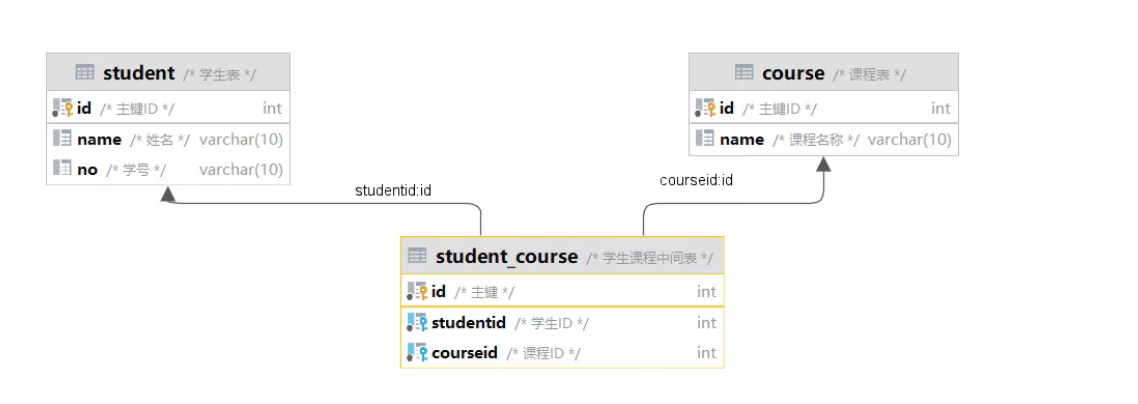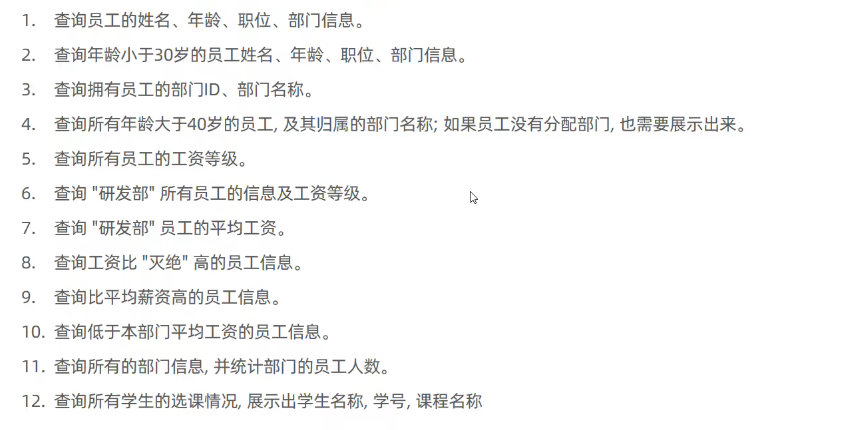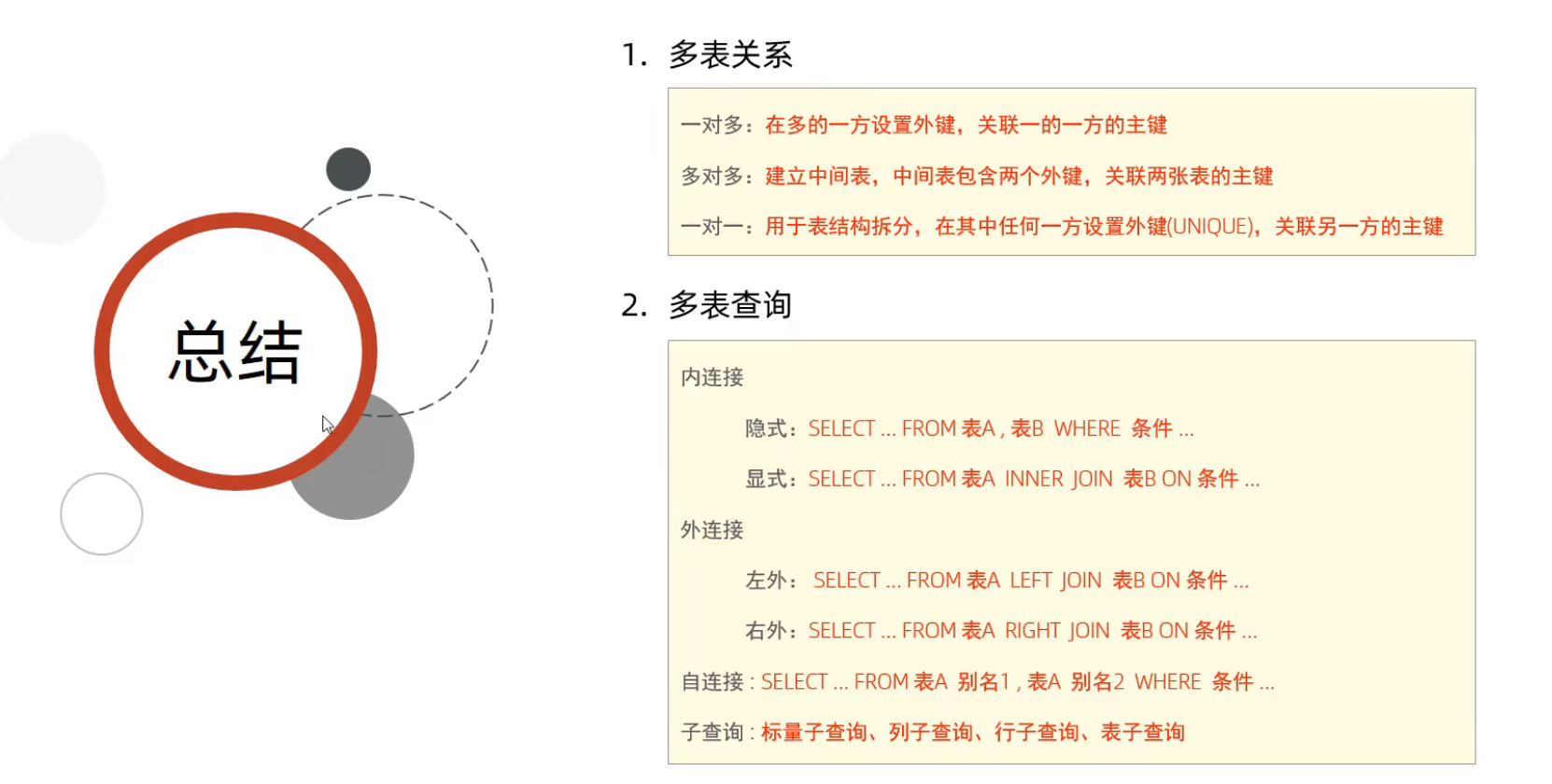
前文回顾:约束
文章目录
[1.2 多对多关系](#1.2 多对多关系)
[1.3 一对一关系](#1.3 一对一关系)
[2. 多表查询概述](#2. 多表查询概述)
[2.1 多表查询的分类](#2.1 多表查询的分类)
[2.1.2 字查询](#2.1.2 字查询)
[3.1 内连接查询语法](#3.1 内连接查询语法)
[3. 2 代码演示](#3. 2 代码演示)
[4. 外连接](#4. 外连接)
[4.1 外连接语法](#4.1 外连接语法)
[4.2 代码演示](#4.2 代码演示)
[5. 自连接](#5. 自连接)
[5.1 自连接语法](#5.1 自连接语法)
[5. 2 代码演示](#5. 2 代码演示)
[6. 联合查询](#6. 联合查询)
[7. 子查询](#7. 子查询)
[7.1 子查询分类](#7.1 子查询分类)
[7.1.1 标量子查询](#7.1.1 标量子查询)
[7.1.2 列子查询](#7.1.2 列子查询)
[7.1.3 行子查询](#7.1.3 行子查询)
[7.1.4 表子查询](#7.1.4 表子查询)
[8. 练习](#8. 练习)
说明:本文章代码演示和练习使用到的数据表在本文章最后
1.多表关系
项目开发中,进行数据库表结构设计时,会根据业务需求及业务模块之间的关系,分析并设计表结构,以各个表结构之间有存在着各种联系,基本上分为三种:
- 一对多(多对一)
- 多对多
- 一对一
1.1一对多(多对一)
- 案例:部门 与 员工的关系
- 关系:一个部门对应多个员工,一个员工对应一个部门
- 实现:在多的一方建立外键,指向一的一方的主键

1.2 多对多关系
- 案例:学生 与 课程的关系
- 关系:一个学生可以选修多门课程,一门课程也可以供多个学生选择
- 实现:建立第三张中间表,中间表至少包含两个外键,分别关联两个主键。

sql
create table student(
id int auto_increment primary key comment '主键ID',
name varchar(10) comment '姓名',
no varchar(10) comment'学号,'
)comment'学生表';
insert into student values (null,'黛绮丝','2000100101'),(null,'谢逊','2000100102'),(null,'般天正','2000100103'),(null,'韦一笑','2000100104');
create table course(
id int auto_increment primary key comment '主键ID',
name varchar(10) comment '课程名称'
)comment '课程表';
insert into course values (null,'Java'), (null,'PHP'), (null,'MySL') ,(null,'Hadoop');
create table student_course(
id int auto_increment comment '主键' primary key,
studentid int not null comment '学生ID!',
courseid int not null comment '课程',
constraint fk_courseid foreign key (courseid)
references course (id),
constraint fk_studentid foreign key (studentid)references student (id)
)comment '学生课程中间表';
insert into student_course values (null,1,1),(null,1,2),(null,1,3),(null,2,2),(null,2,3),(null,3,4);
1.3 一对一关系
- 案例:用户 与 用户 详情的关系
- 关系:一对一关系,多用于单表的拆分,将一张表的基础字段放在一张中,其他详细字段放在另一张表中,以提升操作效率
- 实现:在任意的一方加入外键,关联另一方的主键,并且设置外键为唯一的(UNIQUE)


sql
CREATE TABLE tb_user (
id INT AUTO_INCREMENT PRIMARY KEY COMMENT '主键ID',
name VARCHAR(10) COMMENT '姓名',
age INT COMMENT '年龄',
gender CHAR(1) COMMENT '1: 男, 2: 女',
phone CHAR(11) COMMENT '手机号'
) COMMENT '用户基本信息表';
CREATE TABLE tb_user_edu (
id INT AUTO_INCREMENT PRIMARY KEY COMMENT '主键ID',
degree VARCHAR(20) COMMENT '学历',
major VARCHAR(50) COMMENT '专业',
primaryschool VARCHAR(50) COMMENT '小学',
middleschool VARCHAR(50) COMMENT '中学',
university VARCHAR(50) COMMENT '大学',
userid INT UNIQUE COMMENT '用户ID',
CONSTRAINT fk_userid FOREIGN KEY (userid) REFERENCES tb_user(id)
) COMMENT '用户教育信息表';
INSERT INTO tb_user(id, name, age, gender, phone) VALUES
(NULL, '黄渤', 45, '1', '18800011111'),
(NULL, '冰冰', 35, '2', '18800022222'),
(NULL, '马云', 55, '1', '18800088888'),
(NULL, '李彦宏', 50, '1', '18800099999');
INSERT INTO tb_user_edu(id, degree, major, primaryschool, middleschool, university, userid) VALUES
(NULL, '本科', '舞蹈', '静安区第一小学', '静安区第一中学', '北京舞蹈学院', 1),
(NULL, '硕士', '表演', '朝阳区第一小学', '朝阳区第一中学', '北京电影学院', 2),
(NULL, '本科', '英语', '杭州市第一小学', '杭州市第一中学', '杭州师范大学', 3),
(NULL, '本科', '应用数学', '阳泉区第一小学', '阳泉区第一中学', '清华大学', 4);2. 多表查询概述
- 概述:指的是从多张表中查询数据
- 笛卡尔积:笛卡尔积是指在数学中,两个集合A 和 集合B的所有组合情况(在多表查询时,需要消除无效的笛卡尔积)比如:R 表和 T进行笛卡尔积运算 得到的结果行数等于 T行数 乘以 S行数,列数等于T列数 加 S列数。

所需要的数据表在文章最后准备数据数据中
sql
-- 多表查询 -- 笛卡尔积
select * from emp,dept;
-- 消除无效的笛卡尔积
select * from emp,dept where emp.dept_id = dept.id ORDER BY emp.id; -- 发现查询到了16 条数据,原因id为17的员工没有分配部门,部门为null。2.1 多表查询的分类
2.2.1连接查询
- 内连接:相当于查询A, B交集部分的数据。
- 外连接:
- 左外连接:查询左表所有数据,以及两张表交集部分的数据
- 右外连接:查询右表所有数据,以及两张表交集部分的数据
- 自连接:当前表自身的连接查询,自连接必须使用表别名
2.1.2 字查询
3.内连接
注意 :内连接连接的是两张表交集部分。
3.1 内连接查询语法
隐式内连接
SELECT 字段列表 FROM 表1, 表2 WHERE 条件...;
显示内连接
SELECT 字段列表 FROM 表1 [INNER] JOIN 表2 ON 连接条件...;
3. 2 代码演示
sql
-- 内连接演示
-- 1. 查询每一个员工的姓名,以及关联的部门的名称(隐式内链接)
-- 表结构 : emp, dept
-- 连接条件: emp.dept_id = dept.id
select emp.name as 姓名, dept.name as 部门 from emp, dept where emp.dept_id = dept.id;
-- 给表起一个别名(注意:如果起了别名就不能再使用别名,原来的名字就不能使用了)
select e.name as 姓名, d.name as 部门 from emp e, dept d where e.dept_id = d.id;
-- 2. 查询每一个员工的姓名,以及关联的部门的名称(显示内链接)
-- 表结构 : emp, dept
-- 连接条件: emp.dept_id = dept.id
select emp.name as 姓名, dept.name as 部门 from emp inner join dept on emp.dept_id = dept.id;4. 外连接
4.1 外连接语法
左外连接
SELECT 字段列表 FROM 表1 LEFT [OUTER] JOIN 表2 ON 条件...;
注意:左外连接相当于查询表1(左表)的所有数据 包含 表1和表2交集部分的数据。
右外连接
SELECT 字段列表 FROM 表1 RIGHT [OUTER] JOIN 表2 ON 条件...;
注意:右外连接相当于查询表2(右表)的所有数据 包含 表1和表2交集部分的数据。
4.2 代码演示
sql
-- 外连接演示
-- 1、查询emp表的所有数据,和对应的部门信息(左外连接)
-- 表结构: emp, dept
-- 连接条件:emp.dept_id = dept.id
select e.*,d.name from emp e left outer join dept d on e.dept_id = d.id;
select e.*,d.name from emp e left join dept d on e.dept_id = d.id;
-- 2、查询dept表的所有数据,和对应的员工信息(右外连接)
select d.*,e.* from emp e right outer join dept d on e.dept_id = d.id;
select d.*,e.* from dept d left outer join emp e on e.dept_id = d.id;5. 自连接
- 自连接:当前表自身的连接查询,自连接必须使用表别名
5.1 自连接语法
SELECT 字段列表 FROM 表A 别名A JOIN 表B 别名B ON 条件...;
**注意:**自连接查询,可以是内连接查询也可以是外连接查询。
5. 2 代码演示
sql
-- 自连接
-- 1、查询 员及其所属领导名字
-- 表结构:emp表
-- emp表中managerid所属领导的id
select e1.name,e2.name as 领导 from emp e1 inner join emp e2 on e1.managerid = e2.id;
-- 2.查询所有员工emp 以及领导的名字emp 如果员工没有领导也需要查询出来
select e1.name 员工, e2.name 领导 from emp e1 left outer join emp e2 on e1.managerid = e2. id;6. 联合查询
- 联合查询设计到的两个关键字:union, union all
- 对于联合查询,就是把多次查询结果合并一起,形成一个新的查询结果集。
- 注意:
- 对于联合查询的多张表的列数必须保持一致,字段类型也需要保持一致。
- union all 会将全部的数据直接合并在一起,union会对合并之后的数据去重。
SELECT 字段列表 FROM 表A ...
UNION [ALL]
SELECT 字段列表 FROM 表B ...;
sql
-- union all, union
-- 联合查询
-- 1、将薪资低于 5000 的员工,和 年龄大于 50 岁的员工全部查询出来。
select * from emp where salary < 5000
union all
select * from emp where age > 50;
-- 去重只需要把all去掉即可
select * from emp where salary < 5000
union
select * from emp where age > 50;
select * from emp where salary < 5000 or age > 50;7. 子查询
概念:SQL语句中嵌套SELECT语句,称为嵌套查询,又称子查询。
SELECT * FROM 表1 WHERE 字段名 = (SELECT 字段名 FROM 表2);
**注意:**子查询外部的语句可以是INSERT、UPDATE、DELETE、SELECT 的任何一个。
7.1 子查询分类
根据子查询结果不同,分为:
- 标量子查询(子查询的结果为单值)
- 列子查询(子查询结果为一列)
- 行子查询(子查询结构为一行)
- 表子查询(子查询结果为多行多列)
**根据子查询位置,分为:**WHERE之后,FROM之后、SELECT之后。
7.1.1 标量子查询
- 标量子查询:子查询返回结果是单个值(数字、字符串、日期),最简单的形式,这种子查询称为标量子查询。
- 常用的操作符号:= <> < <= > >=
sql
-- 标量子查询
-- 1、查询"销售部"的所有员工信息
-- 拆分题目:
-- a:查询"销售部"部门ID
select id from dept where name = '销售部';
-- b: 根据销售部门id查询员工信息
select * from emp where dept_id = 4;
-- 子查询查询如下:
select * from emp where dept_id = (select id from dept where name = '销售部')
-- 2、查询在"方东白"入职之后的员工信息
select * from emp where entrydate > (select entrydate from emp where name = '方东白');7.1.2 列子查询
- 列子查询:子查询返回的结果是一列(可以是多行),这种子查询称为列子查询。
- 常用的操作符:IN、NOT IN、ANY、SOME、ALL
|--------|--------------------------|
| 操作符 | 描述 |
| IN | 在指定范围之内,多选一 |
| NOT IN | 不在指定的集合范围内 |
| ANY | 子查询返回列表中,有任意一个满足即可 |
| SOME | 与ANY等同,使用SOME的地方都可以使用ANY |
| ALL | 子查询返回列表的所有值都必须满足 |
sql
-- 列子查询
-- 1、查询"销售部"和"市场部"的所有员工信息
-- a:查询"销售部"和"市场部"的部门id
select id from dept where name = '销售部' or name = '市场部';
-- b:根据部门id,查询员工信息
select * from emp where dept_id in (2, 4);
select * from emp where dept_id in (select id from dept where name = '销售部' or name = '市场部');
-- 2、查询比 财务部 所有人工资都高的员工信息
-- a:查询所有财务部人员工资
select salary from emp where dept_id = (select id from dept where name = '财务部');
-- b:查询比"财务部"薪资都高的员工信息
select * from emp where salary > all(select salary from emp where dept_id = (select id from dept where name = '财务部'));
-- 方式2:
select * from emp where salary > (select max(salary) from emp where dept_id = (select id from dept where name = '财务部'));
-- 3、查询比"研发部"其中任意一人工资高的员工信息
-- a:查询研发部门所有人的工资
select salary from emp where dept_id = (select id from dept where name = '研发部');
-- b:比"研发部"任意一人工资要高的员工信息
select * from emp where salary > any(select salary from emp where dept_id = (select id from dept where name = '研发部'));
-- 方式2
select * from emp where salary > some(select salary from emp where dept_id = (select id from dept where name = '研发部'));
-- 方式3
select * from emp where salary > (select min(salary) from emp where dept_id = (select id from dept where name = '研发部'));7.1.3 行子查询
- 行子查询:子查询返回的结果是一行(可以是多列) ,这种子查询称为行子查询。
- 常用的操作法:= 、<>、IN、NOT IN
sql
-- 行子查询
-- 1、查询与"张无忌"的薪资及直属领导相同的员工信息
-- a:查询与"张无忌"的薪资及直属领导
select salary, managerid from emp where name = '张无忌';
-- b:查询与"张无忌"的薪资及直属领导相同的员工信息
select * from emp where (salary,managerid) = (select salary, managerid from emp where name = '张无忌');7.1.4 表子查询
- 表子查询:子查询返回的结果是多行多列,这种子查询称为表子查询。
- 常用的操作符:IN
sql
-- 表子查询
-- 1、查询与"鹿杖客","宋远桥"职位和薪资相同的员工信息
-- a:查询与"鹿杖客","宋远桥"职位和薪资
select job, salary from emp where name = '鹿杖客' or name = '宋远桥';
-- b:查询与"鹿杖客","宋远桥"职位和薪资相同的员工信息
select * from emp where (job,salary) in (select job, salary from emp where name = '鹿杖客' or name = '宋远桥');
-- 2、查询入职日期是"2006-01-01"之后的员工信息,及其部门
-- a:查询入职日期是"2006-01-01"之后的员工信息
select * from emp where entrydate > '2006-01-01';
-- b:查询这部分员工,对应的部门信息
select * from (select * from emp where entrydate > '2006-01-01') e left outer join dept d on e.dept_id = d.id;
-- 方式2
select * from emp e left outer join dept d on e.dept_id = d.id where entrydate > '2006-01-01';8. 练习

sql
-- 1、查询员工的姓名,年龄,职位,部门信息(隐式查询)
-- 表:emp 、dept
-- emp.dept_id = dept.id
select e.name,age,job,d.name from emp e, dept d where e.dept_id = d.id;
select e.name,age,job,d.name from emp e inner join dept d on e.dept_id = d.id; -- 显示内连接
-- 2、查询年龄小于30岁的员工的姓名,年龄,职位,部门信息(显示内连接)
-- 表:emp 、dept
-- emp.dept_id = dept.id
select e.name,age,job,d.name from emp e inner join dept d on e.dept_id = d.id where age < 30;
-- 3、查询拥有员工的部门ID 、部门名称
-- 表:emp 、dept
-- emp.dept_id = dept.id
select distinct dept_id,d.name from emp e inner join dept d on e.dept_id = d.id;
-- 4、查询所有年龄大于40岁的员工,以其归属的部门名称,如果员工没有分配部门,也需要显示出来
-- 表:emp 、dept
-- emp.dept_id = dept.id
-- 外连接
select e.*,d.name from emp e left outer join dept d on e.dept_id = d.id where age > 40;
-- 5、查询所有员工资等级
-- 表:emp、salgrade
-- 连接条件:emp.salary >= salgrade.losal and emp.salary <= salgrade.hisal
select e.*,s.grade 薪资等级 from emp e ,salgrade s where salary >= losal and salary <= s.hisal;
select e.*,s.grade 薪资等级 from emp e ,salgrade s where salary between s.losal and s.hisal;
-- 6、查询"研发部"所有员工的信息以及 工资等级
-- 表:emp、dept、salgrade
-- 连接条件:emp.dept_id dept.id and e.salary between s.losal and s.hisal
-- 查询条件:dept.name = '研发部'
select e.*,s.grade from emp e,salgrade s, dept d where e.dept_id = d.id and e.salary between s.losal and s.hisal and d.name = '研发部';
-- 7、查询"研发部"员工的平均工资
-- 表:emp.dept
-- 连接条件:e.dept_id = d.id
-- 查询条件:d.name = '研发部'
select avg(salary) from emp e,dept d where e.dept_id = d.id and d.name = '研发部';
-- 8、查询工资比"灭绝"高的员工信息
-- 子查询
select * from emp where salary > (select salary from emp where name = '灭绝');
-- 自身连接
select e1.* from emp e1, emp e2 where e2.name = '灭绝' and e1.salary > e2.salary;
-- 9、查询比平均薪资高的员工信息
-- 子查询
select * from emp where salary > (select avg(salary) from emp);
-- 10、查询低于本部门平均工资的员工信息
-- a: 查询指定部门平均薪资
select avg(e1.salary) from emp e1 where e1.dept_id = 1;
select avg(e1.salary) from emp e1 where e1.dept_id = 2;
-- b:查询低于本部门平均工资的员工信息
select * from emp e2 where e2.salary < (select avg(e1.salary) from emp e1 where e1.dept_id = e2.dept_id);
-- 11、查询所有的部门信息,并统计部门的员工人数
-- a:查询所以部门信息
select * from dept;
-- b:统计每个部门的员工人数
select count(*) from emp where dept_id = 1;
-- 合并上面两部
select d.id, d.name ,(select count(*) from emp e where e.dept_id = d.id) from dept d
-- 12、查询所有学生的选课情况,展示出学生名称,学号,课程名称
-- 表:student,course、sc
-- 连接条件:s.id = sc.studentid and s.id = sc.courseid
select s.name,no,c.name from student s ,course c, student_course sc where s.id = sc.studentid and c.id = sc.courseid;9.此文章用到的表数据
多表查询代码演示以及练习数据
sql
create table dept(
id int primary key auto_increment,
name varchar(10)
);
insert into dept values
(null, '研发部'),
(null, '市场部'),
(null, '财务部'),
(null, '销售部'),
(null, '总经办'),
(null, '人事部');
create table emp(
id int primary key auto_increment,
name varchar(10),
age int,
job varchar(10),
salary int,
entrydate date,
managerid int,
dept_id int,
constraint fk_dept foreign key (dept_id) references dept(id)
);
insert into emp values
(null, '金庸', 66, '总裁', 20000, '2000-01-01', null, 5),
(null, '张无忌', 20, '项目经理', 12500, '2005-12-05', 1, 1),
(null, '杨逍', 33, '开发', 8400, '2000-11-03', 2, 1),
(null, '韦一笑', 48, '开发', 11000, '2002-02-05', 2, 1),
(null, '常遇春', 43, '开发', 10500, '2004-09-07', 3, 1),
(null, '小昭', 19, '程序员鼓励师', 6600, '2004-10-12', 2, 1),
(null, '灭绝', 60, '财务总监', 8500, '2002-09-12', 1, 3),
(null, '周芷若', 19, '会计', 4800, '2006-06-02', 7, 3),
(null, '丁敏君', 23, '出纳', 5250, '2009-05-13', 7, 3),
(null, '赵敏', 20, '市场部总监', 12500, '2004-10-12', 1, 2),
(null, '鹿杖客', 56, '职员', 3750, '2006-10-03', 10, 2),
(null, '鹤笔翁', 19, '职员', 3750, '2007-05-09', 10, 2),
(null, '方东白', 19, '职员', 5500, '2009-02-12', 10, 2),
(null, '张三丰', 88, '销售总监', 14000, '2004-10-12', 1, 4),
(null, '俞莲舟', 38, '销售', 4600, '2004-10-12', 14, 4),
(null, '宋远桥', 40, '销售', 4600, '2004-10-12', 14, 4),
(null, '陈友谅', 42, null, 2000, '2011-10-12', 1, null);
sql
create table salgrade(
grade int,
losal int,
hisal int
) comment'薪资等级表';
insert into salgrade
values (1, 0, 3000),
(2, 3001, 5000),
(3, 5001, 8000),
(4, 8001, 10000),
(5, 10001, 15000),
(6, 15001, 20000),
(7, 20001, 25000),
(8, 25001, 30000);多表查询联系第12题所需要的表
sql
create table student(
id int auto_increment primary key comment '主键ID',
name varchar(10) comment '姓名',
no varchar(10) comment'学号,'
)comment'学生表';
insert into student values (null,'黛绮丝','2000100101'),(null,'谢逊','2000100102'),(null,'般天正','2000100103'),(null,'韦一笑','2000100104');
create table course(
id int auto_increment primary key comment '主键ID',
name varchar(10) comment '课程名称'
)comment '课程表';
insert into course values (null,'Java'), (null,'PHP'), (null,'MySL') ,(null,'Hadoop');
create table student_course(
id int auto_increment comment '主键' primary key,
studentid int not null comment '学生ID!',
courseid int not null comment '课程',
constraint fk_courseid foreign key (courseid)
references course (id),
constraint fk_studentid foreign key (studentid)references student (id)
)comment '学生课程中间表';
insert into student_course values (null,1,1),(null,1,2),(null,1,3),(null,2,2),(null,2,3),(null,3,4);